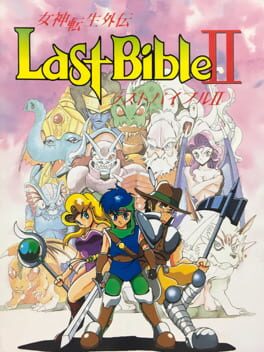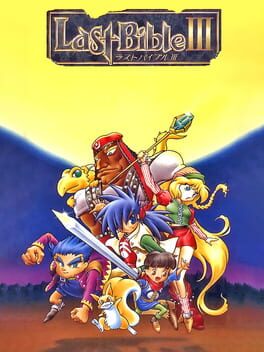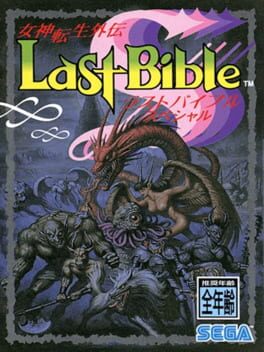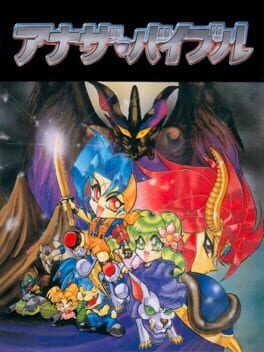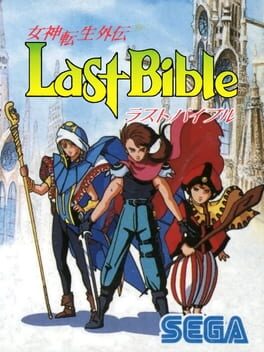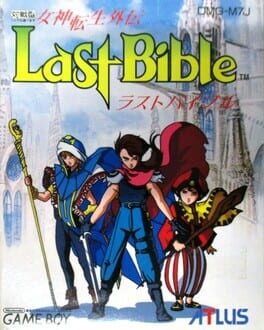

Megami Tensei Gaiden: Last Bible II
released on Nov 19, 1993
Megami Tensei Gaiden: Last Bible II is a role-playing video game series developed by Multimedia Intelligence Transfer, Sega, and Menue, and published by Atlus and Sega for multiple platforms. Players explore the game world and fight monsters in menu-based battles; players can also attempt to recruit monsters to their party, and can fuse two allied monsters into a single new one to try to get stronger monsters.
Also in series
Reviews View More
After enjoying the first Last Bible game so much, I was super stoked to be able to find this copy (which I'd read was just all around better) for so cheap locally. It took me a while to get to it, but I eventually did! XD. It took me around 17 or so hours (no in-game counter, so I gotta guess) to beat the game on real hardware via my GameBoy Player.
The story of Last Bible 2 is in the far, far future of the first game's world, but ultimately not meaningfully connected beyond some related terms. One day, the return of the monster (not demon, monster) king, who was sealed away 2000 years ago, is foretold, and in order to stop this, the kingdom kills all newborn children in an attempt to keep his herald from fulfilling that prophecy. 15 years later, you, a boy named Yuri, and his childhood friend in their monster village go off to the capital to seek adventure and join the army, ultimately (of course) being pulled into a big fight to save the world. There are a lot more characters, both playable and non-playable, who have better motives and development than the first game. It's still not anything truly amazing, but it was certainly a much more technically put together story than the first. The actual facts of what was happening were much more clear, as well as to why characters were doing what they were doing. I think ultimately the story's setup hurts rather than helps the game in other ways, but I'll get to that later ^^;. The story is pretty darn good and text-filled for a GameBoy game, and with the topics its dealing with really does feel closer to what you'd imagine an "SMT game but for kids" would be.
The mechanics of the game are very much like the first one but expanded and enhanced all around in many ways. You still are a main human character with a pool of other human party members, and you still can recruit un-leveling monsters to your side via conversations and fuse those monsters into stronger ones. You can still do monster fusion anywhere via a spell, but the save system has been toned back from "anywhere" to "anywhere that isn't in a dungeon". Those base mechanics have been modified a lot as well. Party members now come and go as story beats dictate, meaning that you need to be careful and modify your supplementary monsters as needed to be able to keep progressing. Monsters are of course fuse-able, but now they can all hold and use items and many can even use equipment too! The monster conversation system has also been significantly enhanced, and it actually feels much closer to the genuine conversational system of its SMT sister games instead of feeling like random A and B choices like Last Bible 1 had. Even the UI is improved, and while still not perfect, it's a lot faster and more convenient to navigate than it used to be (for the most part at least).
While those points are all well and good, but unfortunately Last Bible 2 ends up tripping up pretty hard in some places. A lot of it has to do with item management. There are a lot more banks, so it's a lot easier to manage your key items this time, but not only do human party members keep their inventories when they leave the party, but monsters also completely LOSE their inventories upon being fused. This means you've gotta pay attention to what you want whom to have when you're thinking of doing monster fusion. While it's impossible to lose key items this way (the way the game solves that problem is that monsters simply can't hold key items at all), it's very frustratingly easy to forever lose unique equipment because you forgot to de-equip a monster with it, and it's similarly frustrating to lose a key item or unique piece of equipment because someone you didn't realize was about to leave has left for a good while.
There are also some very confusing design aspects around the human characters in particular. There are six main human party members who cycle through your party throughout the game, and overall they're not very good. Humans are always the weak link of the party, and the fact that they don't level up when they're not in the group means that you're even more likely to ignore them in favor of monster party members when they come back into the party after having been gone for story reasons. This is doubly true given how this game, like the last one, has a lot of unique special monsters you can find who are REALLY powerful and awesome to use. The game then twists in the final act, and actually robs you of ALL of your monsters by giving you all six human party members who cannot be removed from the party (so incidentally, if you have any items on reserve monster party members when you get that sixth human, their items are now inaccessible since only active party member's items can be accessed). I had to grind for hours to get my all-human party to a place where they could actually fight the final boss because they were all so wimpy, as this game is a good deal harder than the original overall. It's not a game-breaking decision, but it definitely left a sour taste in my mouth after a game that was up to that point better than the first game in basically every way.
One aspect that does not disappoint, however, is the presentation. I'd heard the music was just all around better in the second game, even after being so good in the first, and that statement was absolutely right. The graphics have also been improved a bit, still looking quite "GameBoy JRPG"-like, but with the environments and monster sprites looking just a bit nicer than before. They also do a better job of not putting monsters that share a sprite in the same area anymore, so that's one more really nice feature.
Verdict: Recommended. Last Bible 2 is another really good GameBoy JRPG. Overall I'd say it's stronger than its predecessors, but a few too many mistakes in its design philosophy regarding its human party members makes it impossible for me to recommend that highly. If you're a fan of JRPGs, you'll probably quite like this game, and it's well worth checking out if you can read Japanese and like some monster-catching action.
Game Review - originally written by (wraith)
If you've ever played an 8-bit or 16-bit RPG, you already know exactly what this game plays like. I know the term “Dragon Quest Clone” is cliché, but this game fits the term to a button. Except for in battles, everything is represented by 16×16 pixel sprites and tiles, and you interact with your environment and inventory via menus. Of course, being a game that is part of the whole Megami Tensei canon, it kicks a lot more ass than most Dragon Quest clones, and has mythological/theological/occult bent to everything in the game. It looks pretty neat.
If you've ever played an 8-bit or 16-bit RPG, you already know exactly what this game plays like. I know the term “Dragon Quest Clone” is cliché, but this game fits the term to a button. Except for in battles, everything is represented by 16×16 pixel sprites and tiles, and you interact with your environment and inventory via menus. Of course, being a game that is part of the whole Megami Tensei canon, it kicks a lot more ass than most Dragon Quest clones, and has mythological/theological/occult bent to everything in the game. It looks pretty neat.
